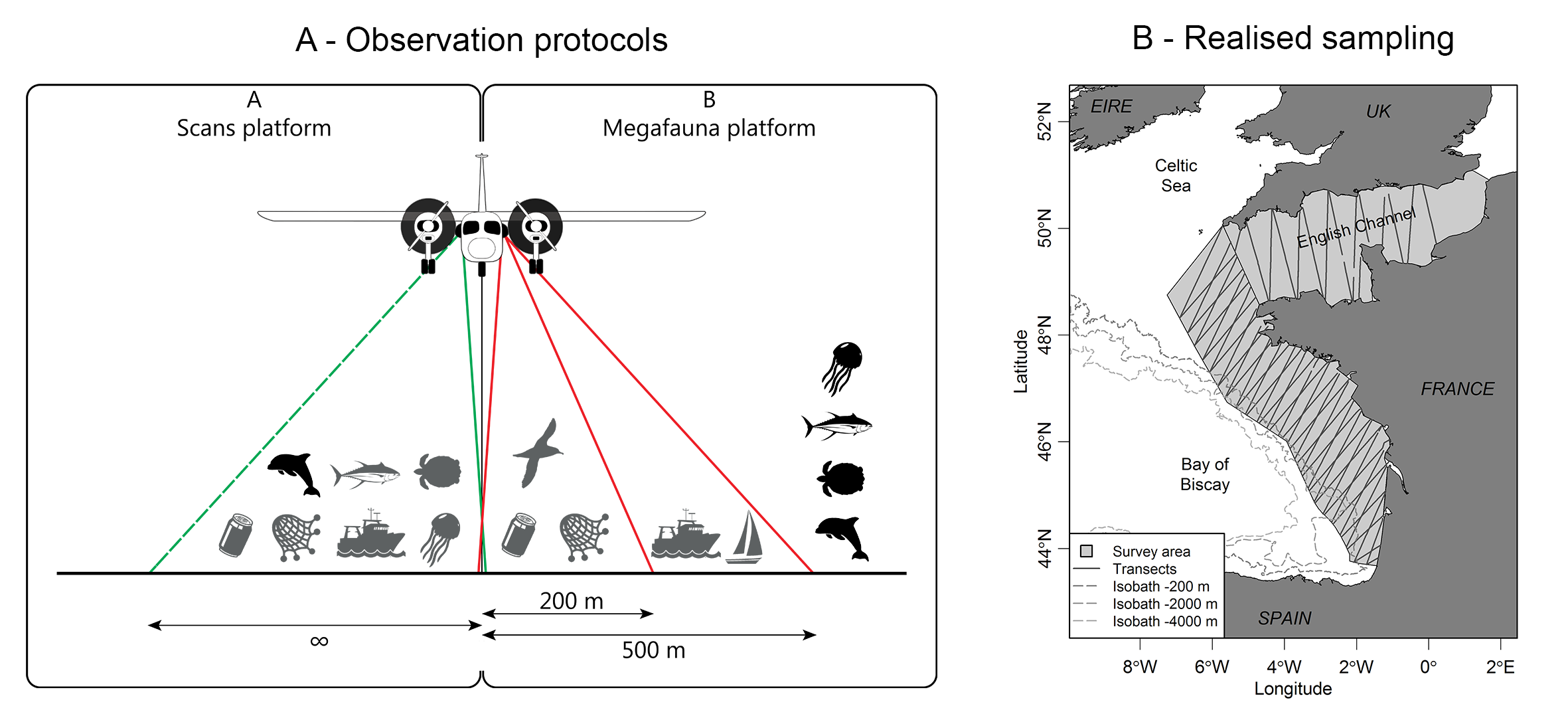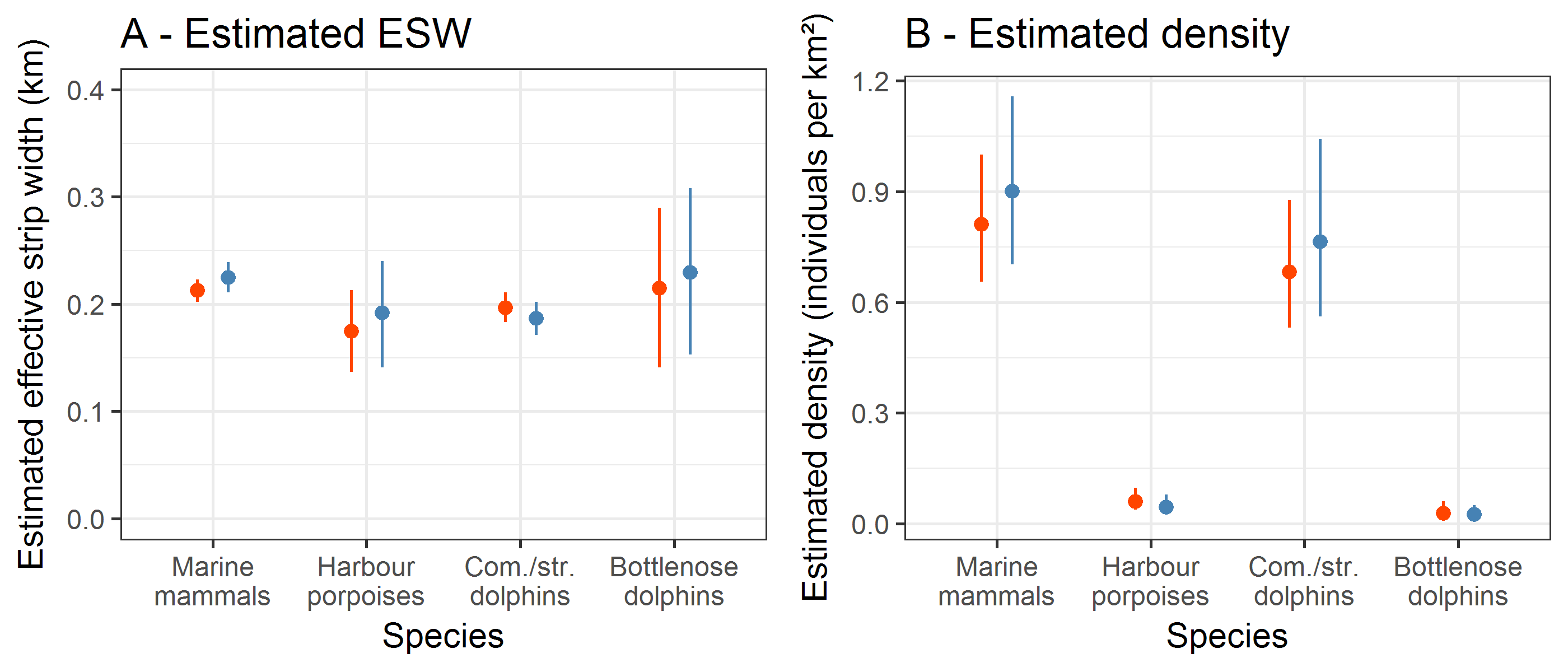Impact of observation protocol on perception and abundance estimation of small cetaceans
Dates: Nov 2016–Oct 2018
Research team: Observatoire Pelagis UMR 3462 La Rochelle Université – CNRS.
Collaborators: Prof Vincent Ridoux, Dr Jérôme Spitz, Dr Matthieu Authier, Dr Sophie Laran, Dr Phil Hammond, Dr Meike Scheidat, Dr Anita Gilles.
This work was part of the 2016 SCANS-III surveys. More specifically, it was the output of the double-platform experiment set-up during the survey. It was published in Royal Society Open Science.
The European Marine Strategy Framework Directive, declared by the European Parliament and Council in 2008, requires Member States to implement conservation measures to restore or maintain Good Ecological Status (GES) of their marine environment. Member States are required to set up Monitoring Programs to produce a set of indicators measuring the realisation of the GES. Large scale surveys are commonly used to furnish precise marine fauna population censuses. Aerial surveys applied to the study of marine megafauna distribution and abundance are common. Two types of protocols can be used for these aerial surveys, mono-target and multi-target protocols, surveying either one or several taxonomic groups, respectively.
A possible caveat of the multi-target protocol is that the detection of animals present at the sea surface could be hindered when other animals are recorded. This is thought to be the case particularly for the detection of cetaceans when simultaneously recording seabirds. Recording a bird flying above the water could indeed distract the observer from the sea surface and reduce his or her capacity to detect an animal present at or beneath the sea’s surface. If the detection of some taxonomic groups is reduced, then there will be a bias in the abundance estimates produced from multi-target aerial surveys. However, in the context of optimisation of both costs and benefits of monitoring, multi-target surveys have crucial advantages including pooling of costs and having lower ecological footprints compared to mono-target surveys. Survey data of multiple species collected simultaneously are also particularly relevant to understanding ecological relationships between several compartments within ecosystems. This type of research is fundamental for the implementation of relevant Monitoring Programs.
During the SCANS-III survey in July 2016 1, a double-platform protocol was implemented within French Atlantic waters. This protocol consisted of a tandem of independent observation teams operating simultaneously within the same aircraft, but using two different survey protocols (below figure). The Scans platform used the same dedicated protocol as the rest of the survey (focused on small cetaceans). The Megafauna platform used a multi-target protocol recording all the marine wildlife visible at the surface, from jellyfishes to cetaceans and seabirds. This multi-target protocol was previously used in the large scale French aerial surveys REMMOA and SAMM, the Irish ObSERVE surveys and the international survey ASI.

The aim of this project was to test for a bias in small cetacean detection and abundance estimation for the multi-target protocol (the Megafauna platform, which included the simultaneous recording of seabirds) compared to the reference, the mono-target protocol (the Scans platform ; above figure). More than 10,400 km were sampled with the double-platform protocol during the SCANS-III survey, providing more than 700 sightings of marine mammals, and over 2,400 sightings of seabirds. Our results showed without ambiguity that the two platforms furnished similar encounter rates and detection parameters (Effective Strip half-Width), which provided similar abundance estimates for both platforms (see below). These results held for the four studied taxonomic groups (small cetaceans ; harbour porpoise ; common and striped dolphins ; bottlenose dolphin), and whatever was the observed density of anthropogenic objects, seabirds and other marine wildlife.

The results of our study also demonstrated that, at the sighting scale, small cetacean perception was impacted by the detection of other objects. In both observation protocols, small cetacean perception was better when another cetacean had been detected within the previous 30 seconds, but was lower when a seabird had been detected for the Megafauna platform. This perception bias is supposed to have had a reduced impact in areas where small cetaceans occurred in high densities, since seabirds and small cetaceans are predominantly inversely distributed in the study area (seabirds inshore and small cetaceans offshore). Furthermore, this bias occurred at a 30 seconds scale and it could therefore have had only a limited effect on cetacean abundance estimations done at a larger scale.
Our results indicate that despite a negative correlation between seabird detection and small cetacean perception, the multi-target protocol did not induce any bias in small cetacean censuses and permitted to obtained abundance estimates similar to those obtained using the reference mono-target protocol. Thanks to the double-platform protocol implemented during the SCANS-III survey we conclude that the use of multi-target protocols, which are already well established in aerial surveys (REMMOA, SAMM, ObSERVE and ASI), together with the implementation of a sampling scheme adequate for the target taxonomic groups, would ensure a scientifically sound census of marine megafauna.
